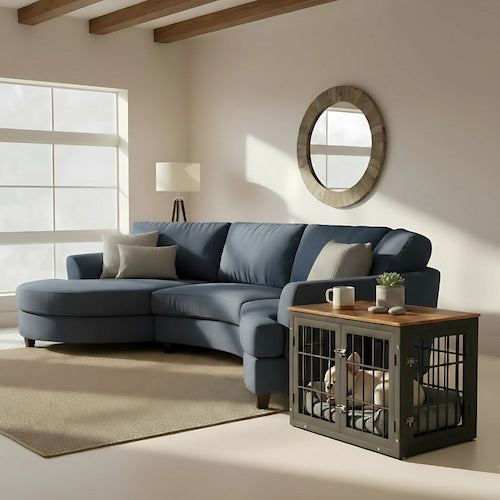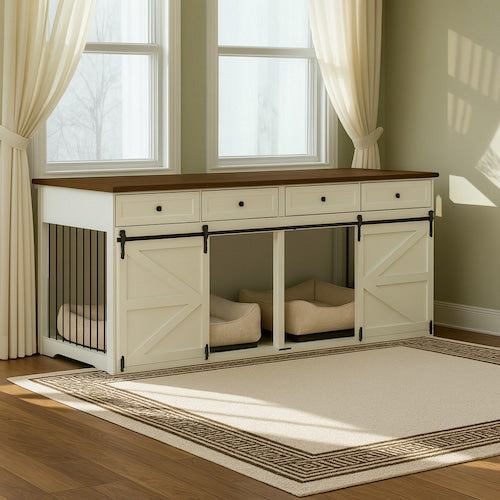What Is The Best No Pull Harness to Stop Pulling?
Welcome to our comprehensive guide on finding the best no-pull harness for your furry friend! As avid dog enthusiasts, we understand the challenges of managing a pup that tends to pull during walks. After rigorous testing and evaluation, our dedicated team at OnePaw has narrowed down the options to unveil the ultimate solution.
In this blog post, we will unravel the top-performing no-pull harnesses, sharing insights, features, and real-world experiences to help you make an informed decision. Say goodbye to pulling woes and embark on enjoyable walks with your canine companion as we unveil the key to a tangle-free and comfortable experience.

What Is the Difference Between a Regular Harness and No Pull Harness?
-
Front Attachment Point: One of the defining features of a no pull harness is the leash attachment point located at the front of the chest, rather than on the back. This strategic placement redirects a dog's attention towards the owner when they attempt to pull, encouraging them to walk beside rather than ahead.
-
Tightening or Pressure Mechanism: Some no pull harnesses incorporate a tightening or pressure mechanism that activates when the dog pulls. This slight discomfort serves as a deterrent, teaching the dog to walk without pulling to avoid the sensation.
-
Training Accessories: No pull harnesses may come with additional training accessories, such as a dual-clip system allowing the owner to choose between front and back attachment points based on the dog's behavior and training progress.

How does a No Pull Harness Work Exactly?
The front-clip changes the point of leverage because the leash is attached to the front of the dog. If they pull the effect is that the leash gives a tug on their chest to the side, therefore turning the dog toward you and not allowing them to move forward. So if they pull, they get turned. And if they turn, they aren’t heading forward which is where they want to be going and why they are pulling.

With an exclusive 50% discount available through our link today, take a significant step toward transforming your dog's walks. Our innovative no pull harness not only ensures a secure and comfortable fit but also solves the persistent problem of pulling. Make walks easier and more delightful for both you and your beloved pet.
So Which Harness Is Best?
After putting numerous no-pull harnesses to the test, our journey led us to the undeniable conclusion that the Reflective No-Pull Harness stands head and shoulders above the rest.
Having rigorously experimented with various options, we found that the high-quality reinforced military-grade padded nylon not only ensures longevity but also prioritizes your dog's ease during walks. The inclusion of multiple attachment points was a game-changer, providing unparalleled control and effectively curbing pulling tendencies. The metal buckles added an extra layer of durability, securing the harness in place throughout our trials.
The quick control handle emerged as a standout feature, allowing for swift interventions when needed. Moreover, the reflective material not only enhances visibility but also reflects our commitment to safety during low-light walks. In the realm of no-pull harnesses, our exhaustive testing has revealed that this one stands as the epitome of quality, functionality, and overall excellence, ensuring that you and your furry companion can embark on walks with unmatched comfort and control.
Ways a Regular Harness May Contribute to Pulling:
-
Back Attachment Point: Most regular harnesses have a leash attachment point on the back. While this positioning provides control, it can also allow the dog to pull with more strength. The back attachment point doesn't provide as much leverage for redirecting the dog's attention.
-
Lack of Discouragement: Traditional harnesses are designed to evenly distribute pressure, but they may not actively discourage pulling. If a dog is not trained to walk politely on a leash, the even pressure distribution may not provide sufficient feedback to deter pulling behavior.
-
Unintentional Reinforcement: Owners may unintentionally reinforce pulling behavior by allowing the dog to move forward when pulling occurs. If the dog learns that pulling leads to getting where they want to go, they are more likely to continue this behavior.
By understanding these dynamics, dog owners can make informed decisions when choosing between a regular harness and a no pull harness. The key is to select a harness that aligns with the dog's behavior, training needs, and the owner's preferences for a more enjoyable walking experience.

How Does A No Pull Harness Work?
One of the primary concerns we have as dog parents is our pet's well-being. No pull harnesses come to the rescue by reducing strain on our dog's neck, preventing potential injuries. These harnesses are also designed to discourage pulling, making our daily walks more enjoyable for both us and our four-legged pals.
Other Benefits Include:
-
Enhanced Control: No pull harnesses often feature front attachment points, strategically placed on the chest. This positioning provides dog owners with improved control over their pets' movements, making it easier to guide and redirect them during walks.
-
Prevention of Escaping: Some dogs are master escape artists, slipping out of their collars or harnesses. No pull harnesses typically offer a more secure and snug fit, reducing the risk of your dog slipping out and ensuring a safer walking experience.
-
Comfortable Padding: Many no pull harnesses come with added padding in key areas, such as the chest and straps. This padding not only enhances comfort for your dog but also reduces the likelihood of chafing or irritation, particularly during more extended walks.
-
Versatility in Training: No pull harnesses can be valuable tools in training your dog to walk politely on a leash. With consistent use, these harnesses can contribute to positive behavior reinforcement, encouraging your dog to adopt better leash manners over time.
-
Reflective Elements for Safety: Several no pull harnesses come equipped with reflective materials, enhancing visibility during low-light conditions. This added safety feature ensures that you and your dog remain visible to passing vehicles and pedestrians, reducing the risk of accidents.
- Customizable Fit: Many no pull harnesses are adjustable, allowing you to achieve a customized fit tailored to your dog's size and body shape. This adaptability ensures maximum comfort and effectiveness, regardless of your dog's breed or build.

With an exclusive 50% discount available through our link today, take a significant step toward transforming your dog's walks. Our innovative no pull harness not only ensures a secure and comfortable fit but also solves the persistent problem of pulling. Make walks easier and more delightful for both you and your beloved pet.
Training Considerations
While no pull harnesses often offer quicker results and a more positive walking experience, it's important to emphasize that they should be used in conjunction with regular training for the best and most lasting results. Being good pet parents means being good trainers, and combining the benefits of a no pull harness with consistent training ensures a harmonious walking experience for both you and your furry friend.
Final Thoughts
As we wrap up our journey through the leash struggle, let's remember that the key lies in choosing the harness that best suits our dog's unique needs. Whether it's the even pressure distribution of a regular harness or the pulling deterrent features of a no pull harness, the goal is to enhance our walking experience and keep our furry friends safe and happy.
By sharing insights and experiences, we hope to guide our fellow dog parents through the harness dilemma and make the right choice for their cherished companions. After all, a happy dog makes for a happy owner!
For more products to keep your dog happy and healthy, explore our selection here. You can also find valuable resources for you and your dog on our Pet Parent Resources Page







Leave a comment